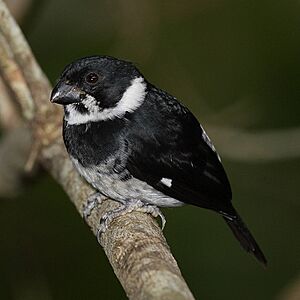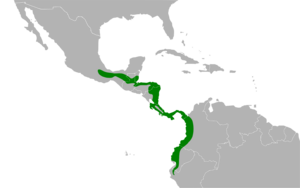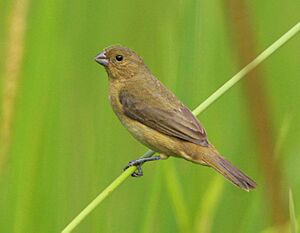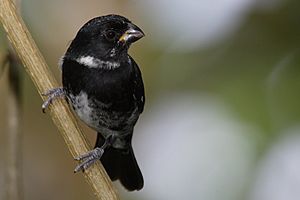Variable seedeater facts for kids
The variable seedeater (Sporophila corvina) is a small passerine bird. It lives and breeds from southern Mexico through Central America. You can also find it in the Chocó region of northwestern South America. This bird is known for its many different looks, especially in its feathers. It used to be thought of as a type of Sporophila americana.
Quick facts for kids Variable seedeater |
|
|---|---|
 |
|
| A male near Panama City, Panama. | |
| Conservation status | |
| Scientific classification | |
| Genus: |
Sporophila
|
| Species: |
corvina
|
 |
|
| Synonyms | |
|
Sporophila aurita |
|
Contents
What Does the Variable Seedeater Look Like?
The variable seedeater is a small, strong bird. It has a black, cone-shaped beak. This bird is about 10.5 cm (4.1 in) long. It weighs around 11 g (0.39 oz). There are four main types, called subspecies. They mostly look different in the male birds' feathers.
Different Types of Male Seedeaters
- S. c. corvina – This type is found from southern Mexico. It lives along the Caribbean coast from Belize south to Panama. Adult males are all black. They have a small white patch on their wings. Their wing linings are also white.
- S. c. hoffmannii – This type lives on the Pacific coast of Costa Rica and Panama. Males look like S. c. corvina males. But they have a white half-collar, rump, and belly.
- S. c. hicksii – You can find this type in eastern Panama. It also lives in nearby northwestern Colombia. Males are similar to S. c. hoffmannii. However, their whole throat is white. Only a small part of their chin or cheek might be black.
- S. c. ophthalmica – This type is in southwestern Colombia. It also lives in western Ecuador and far northwestern Peru. Males are very much like S. c. hicksii. They have a purer white rump and sides.
Sometimes, male seedeaters can have unusual colors. One male bird in Ecuador was reported in 2005. It had more dark pigment, making its white areas a bright reddish-brown. A similar bird was found in Panama in 1963. These color changes can help scientists understand how new species might form over time.
Female and Young Seedeaters
Female variable seedeaters are olive-brown on top. They are lighter underneath. Like the males, they have white wing linings. The differences between female types are small. Females of S. c. hoffmannii, S. c. hicksii, and S. c. ophthalmica are usually paler. They are less brown than S. c. corvina females. They often have a light yellow tint underneath.
Young seedeaters look like the adult females of their type. Males might not get their full adult feathers in their first year. They can still breed even if they look a bit like younger birds.
Understanding the Variable Seedeater's Family Tree
The way scientists group these birds can be a bit tricky. The variable seedeater, Sporophila corvina, used to be considered a type of Sporophila americana. That bird lives in northeastern South America. Scientists decided to separate them into different species. This was based on research by Stiles in 1996.
There was also confusion about the correct scientific name. The name Sporophila aurita was given 10 years before S. corvina. Many thought it was the right name. But the original example of S. aurita disappeared. Its first description was also very unclear. This made it impossible to know which bird it referred to. So, S. corvina became the correct name.
Even after these changes, the males of these birds still look very different. This is why the name "variable seedeater" fits them so well. The mostly black S. c. corvina was once thought to be its own species, called the black seedeater. But all these types can breed together easily where they meet. Because of this, scientists no longer see them as separate species. In many parts of Costa Rica and Panama, it's hard to tell which type a bird belongs to. This is because they often have features from different subspecies mixed together.
Where Variable Seedeaters Live and What They Eat
This seedeater is a common bird. You can find many of them in lowlands and foothills. They live up to 1,500 m (4,900 ft) high. They prefer open areas like forest edges, roadsides, and gardens. They also gather with other seedeater species in grassy fields and pastures.
This bird mainly eats grass seeds. But it also eats other seeds, berries, and some insects.
Nesting and Reproduction
The female builds a simple, cup-shaped nest. It is made of rough plant material. It is lined with a few finer fibers. The nest is placed in a tree, usually 0.4 to 6 m (1.3 to 19.7 ft) high. It is often in the fork of a small branch. The female lays two or three pale grey eggs. These eggs have brown speckles. The female sits on the eggs alone for 12–14 days until they hatch.
The variable seedeater has a harsh chur call. The male's song is a mix of warbles, whistles, and twitters. The song is more complex on the Pacific side of their range.




